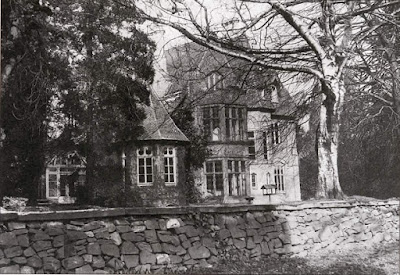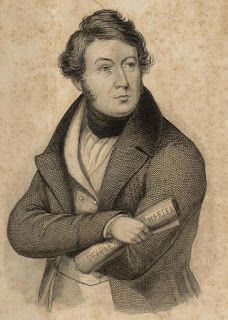Thomas Mawson in Monmouthshire
 |
| By kind permission of Newportpast.com |
I was invited to write an article on Thomas Mawson in Wales for this Spring’s edition of Oriel, the magazine of the Friends of National Museum Wales. Mawson was the foremost landscape architect of his time (1861-1933) and the most notable of his designs in Wales are Dyffryn Gardens and Belle Vue Park, about which I have written in a blog for the MAA last year. My recent research covering the whole of Wales revealed more than I expected, especially in Monmouthshire. Mawson had four commissions in our county, one in Blackwood at Maes Manor and three in Newport, of which two are parks and one a private house.
Maes Manor at Blackwood near Newport was originally known as Maesruddud and is now an hotel set in the countryside. British Listed Buildings notes it warrants Grade II status as an example of a small early C20th industrialist's country house retaining its original character, and representative of the early C20th prosperity of the mining industry in this part of S Wales. [1] The earlier phase of the present house was built for Captain Edmund Williams, local mine owner and Sheriff of Monmouthshire. The second phase was added for L. Brewer Williams when the well preserved terraced Edwardian garden was designed by Thomas Mawson.
 |
| Maes Manor: Mary Evans, 2021 |
 |
| Maes Manor: Viewed from the garden is the Chartist Bridge with artistSebastien Boyeson's Chartist Man Statue Mary Evans 2021 |
Beechwood Park Newport (1900 ) Parks and Gardens UK notes is very little altered with landscaping in the Mawson style, probably by Mawson himself.
 |
| Mary Evans, 2020 |
Newport City website tells us Grade II listed Beechwood House was built in 1877-78 as the private residence of George Fothergill, a tobacco manufacturer and former Mayor of Newport and the 30 acre park originally formed the private grounds. [2] In 1900, Newport Borough Council bought Beechwood House and the grounds were opened up as a public park. During World War I, the house was used as a convalescent home and was occupied by American forces during World War II. It then had a number of uses including a hospital for the treatment of tuberculosis, an open air school and a model railway club. The original house still stands and is shown in my photo above.
 |
| Newport Encyclopaedia: Coronation Year And Royal Visit Souvenir by kind permission of Newport Reference Library |
Many of Mawson’s gardens in Wales have disappeared or have been overlaid and the private Mawson commission in Newport is one example which no longer exists. I knew nothing about it until I read the authoritative book (2009) on Thomas Mawson by Janet Waymark (kindly lent to me by fellow MAA member Anne Dunton). The book names St Mary’s Lodge Newport in a comprehensive list of his dated commissions from 1887 to 1929 but gives no other information on the Lodge. [3] After several searches online I found the website of NewportPast.com had several relevant images with text. [4] In 1900 Sir Thomas Edward Watson J P, colliery and shipping proprietor, commissioned Mawson to design a garden for his house, St Mary’s Lodge. It was a surprise to discover this was located close to where I live and that 110 years ago another Mary Watson, (my maiden name) wife of Sir Thomas resided in the area where I now live. When he died in 1921 Sir Thomas’s daughter Ada Beatrice inherited the house and lived there until 1937 when she donated it for demolition to Newport Borough to make way for the building of its Civic Centre. In the same year King George VI, with Queen Elizabeth, visited Newport to cut the first sod which started the construction of the Civic Centre. [5] Haydn Davis records in his History of Newport that this took place in the pretty rose garden of St Mary’s Lodge pictured above along with the silver spade he used. [6]
He adds that:
“Queen Elizabeth then complimented Miss Watson on her garden, sympathised over its forthcoming destruction, told the Lord Lieutenant that he had lost a silver buckle from his shoe, pointed out where it lay in the grass and then the Royal Couple were on their way to Cardiff to continue their tour of the Principality."
 |
| By kind permission of Newportpast.com |
St Mary’s Lodge, pictured above, was located between Clytha Park Road and Godfrey Road,. It featured In the 1911 census with its own page entry which details 15 rooms and 7 residents, four of whom are family and 3 are servants.
 |
| By kind permission of Newport Past.com |
British Listed Building tells us Kemeys Folly was built in 1722 by George Kemeys of Kemeys Manor, as a hunting lodge. [7] It was rebuilt in the early 20th Century and converted into a residential dwelling for Sir T E Watson. However, it recently underwent a remarkable transformation which featured on Channel 4’s Grand Designs Programme.
Newport’s Civic Centre is a Grade II listed building and its construction started in1938 but did not include the clock tower which was considered to be a good navigation point for enemy bombers. Above is a picture of a reproduction of a photograph presented to the King on his visit in 1937. Construction resumed in the early 1950s but it was not until 1964 that the clock tower, entrance hall and grand staircase were completed. The tower was a contentious issue at the time because of the cost. My father was Leader of Newport Council (Stewart McDougall Watson OBE BEM 1919 – 2005 and Mayor 1971-1972) and I remember one angry rate payer suggested in the South Wales Argus that he should be hung from the tower.
The base of the completed clock tower contains a collection of 12 murals by the German artist Hans Feibusch. John Newman writes of the murals, commissioned in1961 and completed in 1964:
‘As a scheme of municipal decoration, it is perhaps unsurpassed in twentieth century Britain.’ [8]
They depict the history of the City from Celtic times to the building of the George Street Bridge over the River Usk. The MAA had a memorable visit to the murals a few years ago. This picture is a recent photo of the area where St Mary’s Lodge would have stood.
.
 |
| Andrew Evans 2021 |
When I started the research for the article on Mawson for the magazine of the Friends of National Museum Wales I did not expect to find that Thomas Mawson had designed a garden not far from the bottom of the avenue where I live. That is where St Mary’s Lodge was located before it was demolished. I have also discovered just how prolific and influential a designer Mawson was and how his philosophy stressed the importance of gardens to the enrichment of our lives. The Covid pandemic has demonstrated how much we all need nature in our lives. Almost 90 years after his death little could Thomas Mawson know that parks and gardens, private and public, would be vital to the well being of all our lives in a world of Covid 19.
Acknowledgements
My thanks for his help to Nigel Young who manages the website NewportPast.com. And to Lionel Clauzon of Newport Reference Library and Anne Dunton, fellow MAA member.
Sources
1. British Listed Buildings
2.Newport Gov. Webpage Parks.
3. Janet Waymark. Thomas Mawson – Life, Gardens and Landscapes. Published by Frances Lincoln. 2009
4. NewprtPast.com http://www.newportpast.com/gallery/photos/php/photo_page.php?search=talbot&pos=4
5. Newport Encyclopaedia. Coronation Year And Royal Visit Souvenir. 1937, p 208. Published by R C Slade.
6.Haydn Davis. The History of the Borough of Newport. Pennyfarthing Press. 1998. pp 260-261
7. https://britishlistedbuildings.co.uk/300017072-kemeys-folly-langstone#.YBqJ6i3fWhA
8. John Newman. The Buildings of Wales: Gwent/Monmouthshire, 2000)



Comments
Post a Comment